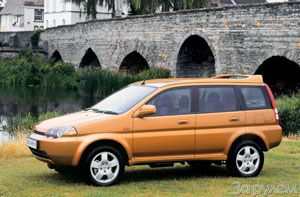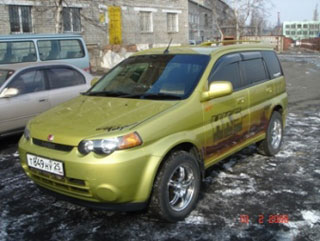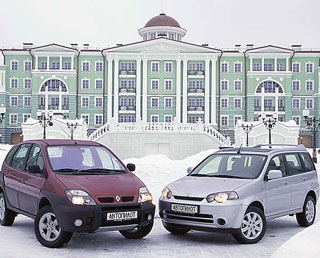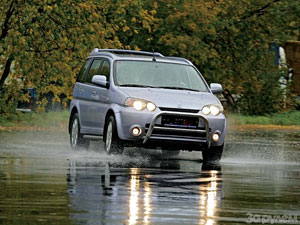Test drive Honda HR-V 5 doors 2001-2006 SUV
Extraclassic element
Such jeep -like universals and such cars have not yet been history in history. But in 1998, Japanese designers and marketers got to the point: HR-V instantly won the hearts of customers (and, of course, customers!) All over the world And this is despite the modest interior and rather poor equipment. In addition, until 2000 in Europe, the only 1.6 liter engine, 105 hp, was proposed, until the only alternative to the 125-horsepower engine of the same volume (see the history of the model) was again.
And this is despite the modest interior and rather poor equipment. In addition, until 2000 in Europe, the only 1.6 liter engine, 105 hp, was proposed, until the only alternative to the 125-horsepower engine of the same volume (see the history of the model) was again. A successful compromise between the grace of forms, high landing, capacity and compactness allows the use of HR-V for travel to work and to the market, on vacation and on a picnic. Do not forget what many choose Honda, outstanding handling, despite the high center of gravity and the dependent rear suspension of this model. Automatically connected all -wheel drive (under ordinary conditions it is a front -wheel drive car) an additional trump card for Russia. However, the obstetors of the off -road recall that the swamp and the delayed tractor track is not for this machine. But the clearance of 170 mm allows not to be too afraid of puffin and buuse. And there are also completely asphalt HR-V with a drive only on the front wheels.
There are a lot of these cars in the Russian market. The prices for restyled specimens are still high (more than 20 thousand dollars), but the first -year cars have fallen in price to 1115 thousand. Structurally, they are practically identical, and HR-V does not have childhood diseases, so among 57-year-old cars you can find quite worthy. But you still need to choose with addiction, remembering the high prices for branded service and original spare parts.
 A hundred or two
A hundred or two Honda high -speed engines are reliable: if you strictly observe the regulations, they will not present unpleasant surprises. In the regulations, the score is hundreds of thousands of kilometers. After the first hundred, the timing belt is changed (original videos usually serve with the second belt, no mandatory replacement is provided), after 200 thousand km or after 5 years, the cooling liquid (subsequently it is prescribed to renew every 100 thousand or 3 years). After the second hundred, it is worth prophylactically changing the pump: until the fourth hundred it may not live, and the belts still have to remove. By the way, if you saw traces of the fluxes of the antifreeze near the drainage hole in the left rear of the engine, this is the first signal.
The cliffs of the original belts behind the honda are not noticed, the gaps in the valves (they are adjusted as on the engines by the stubborn screw of the pusher) in good oil do not go to 100 thousand km, so the cost of service here is minimal oil every 10 thousand km. Motor oil synthetics or semi -synthetics of a quality level not lower than SJ API.
Oil picture
 Variator (CVT) is one of the highlights of Honda HR-V. The traditional planetary automatic machines were not offered to this model, especially since the CVT box has established itself well. A smooth, without jerking and at the same time powerful acceleration at optimal revolutions of the motor can only upset the engine for the engine boring on one note. The dynamics with the variator is even better than with mechanics, and braking by the engine is quite effective. However, we will still recommend that fans recommend the manual transmission. The variator does not like a sharp, torn ride from it, the starting clutch and the reverse mechanism wear out. When buying, sort through all CVT modes, try to move smoothly. If the choice of modes is accompanied by blows in the transmission, and touching the impetus, it is better to refuse such a car. Replacing individual parts of the mechanism rarely helps, and the assembly assembly is very expensive. For CVT until 2002, the original CVT Transmission Fluid oil is provided, since 2002 ATF Z1. It is also suitable for an old car instead of CVTTF, but the reverse replacement is unacceptable. Replacement interval 40 thousand km.
Variator (CVT) is one of the highlights of Honda HR-V. The traditional planetary automatic machines were not offered to this model, especially since the CVT box has established itself well. A smooth, without jerking and at the same time powerful acceleration at optimal revolutions of the motor can only upset the engine for the engine boring on one note. The dynamics with the variator is even better than with mechanics, and braking by the engine is quite effective. However, we will still recommend that fans recommend the manual transmission. The variator does not like a sharp, torn ride from it, the starting clutch and the reverse mechanism wear out. When buying, sort through all CVT modes, try to move smoothly. If the choice of modes is accompanied by blows in the transmission, and touching the impetus, it is better to refuse such a car. Replacing individual parts of the mechanism rarely helps, and the assembly assembly is very expensive. For CVT until 2002, the original CVT Transmission Fluid oil is provided, since 2002 ATF Z1. It is also suitable for an old car instead of CVTTF, but the reverse replacement is unacceptable. Replacement interval 40 thousand km. With the same frequency, it is supposed to change the oil and the original MTF (Manual Transmission Fluid) in the IAC. With it, the gearbox without complaints serves more than 300 thousand km. As an exception, motor is also suitable, only mineral oil is necessarily 10W40; Its maximum service life is 20 thousand km.
 In the rear bridge of all-wheel drive HR-V, the original power mechanism with two DPS pumps (Dual Pump System) is mounted. One pump is given from the cardan shaft, the other from the wheels, with the difference in their speeds, the pressure difference occurs, which drives the mechanism of connecting the bridge. The regulatory interval of DPSF oil replacement 120 thousand km, but it is necessary to update it much earlier after about 6070 thousand km. To this run on steep turns in the bridge there is a grunting sound means that the oil has lost its properties and the wear of the details began. If you continue to ride the old oil, wear will progress, and by 150,200 thousand km will have to buy a new hydropaket.
In the rear bridge of all-wheel drive HR-V, the original power mechanism with two DPS pumps (Dual Pump System) is mounted. One pump is given from the cardan shaft, the other from the wheels, with the difference in their speeds, the pressure difference occurs, which drives the mechanism of connecting the bridge. The regulatory interval of DPSF oil replacement 120 thousand km, but it is necessary to update it much earlier after about 6070 thousand km. To this run on steep turns in the bridge there is a grunting sound means that the oil has lost its properties and the wear of the details began. If you continue to ride the old oil, wear will progress, and by 150,200 thousand km will have to buy a new hydropaket. For replacement, it is better to take two liters of oil: one will go for washing (for pumping the system, rotating the rear wheels are held while the car is hanging on the lift), the other for the final fill (in principle, any ATF can be washed, it is almost completely drained). There is another way to avoid the early replacement of DPSF pour new generation VTM4 oil (Honda releases it for other models). It protects the details much better and without any problems serves the due 120 thousand km.
No less demanding on the oil and power steering. A common ATF destroys it once and for all. Only the Honda PSF (Power Steering Fluid) fluid is suitable for him, but it is possible that it will not be required: the regulation is not provided, with the exception of obvious signs of wear (strong darkening and burning smell). It is best to change the liquid with a consistent substitution (ZR, 2003, No. 4, p. 246).
Big original
 Original spare parts for Honda are roads, but they are reliable and pay for long -term operation with more than. So, the clutch on HR-V is more than 200 thousand km, the cardan shaft is 150 200 thousand (it is not a non-combination and changes in the collection). The steering rack is almost eternal, like the Gur pump, and the tips will last at least 100 thousand km.
Original spare parts for Honda are roads, but they are reliable and pay for long -term operation with more than. So, the clutch on HR-V is more than 200 thousand km, the cardan shaft is 150 200 thousand (it is not a non-combination and changes in the collection). The steering rack is almost eternal, like the Gur pump, and the tips will last at least 100 thousand km. There are no complaints about the brakes. The rear drum, they have to be controlled only every 80100 thousand km. The front discs, despite the low admission to wear (0.5 mm per side), also serve a lot (the pads are enough for 4080 thousand km). Their main enemy is salt and rare trips. The discs rust, and the pads begin to unevenly fit to the surface of the disk, the irregularities appear and the difficult to trim, the drunk layer of the scale. Sometimes such defects can be eliminated with a groove. Thermal deformation of the disks (from overheating and sharp cooling) was not observed on HR-V. The ABS system is also reliable. The brake hoses are designed for the entire service life, and the DOT-4 liquid is changed every three years.
The HR-V body is galvanized to the roof and resists corrosion very well. At least, without outside help, rust, even on the cars of the first years, has not yet appeared. However, an additional anticorront will not hurt, especially if you travel a lot along the graders and primers
 Honda does not put shelters in the rear arches.
Honda does not put shelters in the rear arches. Who used to be with her
The HR-V electrical equipment is almost reliably sealrated without failure, and the wire harnesses are protected by additional insulation. But when buying a car with a signaling that controls the central lock, try to check how the installers connected the wires: many, without thinking twice, drill the connector in the driver's door, and after a while the contacts are oxidized to change the entire tourniquet. By the way, there will be enough standard immobilizer to protect against ordinary hijackers (a response chip in the ignition key), all cars were equipped with them.
Pay attention to the rear speakers: there are few places for them, so when trying to implant non -native acoustics, they often damage plastic.
The initial ignition ahead of the ignition is traditionally set for Honda by hand, turning the distributor body. It is not required to regulate it, but to check, especially if traces of intervention are visible, is useful. Do not forget to close the corresponding contacts of the diagnostic connector. The connector is useful and far from the branded technical center, it allows you to consider error (malfunctions) codes using indicators on the instrument panel (Engine, CVT, SRS, ABS).
 Disconnecting the battery here does not cause problems, only electric windows forget the extreme provisions. To recall them, it is enough for a few seconds to hold the key after the glass reaches the stop.
Disconnecting the battery here does not cause problems, only electric windows forget the extreme provisions. To recall them, it is enough for a few seconds to hold the key after the glass reaches the stop. The history of the model
1998. The three-door Honda HR-V is represented. Sixteen -valve gasoline engine, 1.6 liters, 77 kW/105 hp. (D16W1). Transmission M5 or A (CVT), 4x4 Real Time or front -wheel drive.
1999. The five -door version (the base is increased by 100 mm, the increase went to the rear passengers). The new engine is gasoline, sixteen -valve, with the VTEC system, 1.6 l, 92 kW/125 hp. (D16W5).
2002. Restyling: The front part and interior of the car have changed, fog lights appeared in the bumper.






Anatoly Sukhov
Source: The magazine "Driving"








